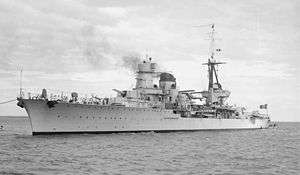Italian cruiser Raimondo Montecuccoli
 Raimondo Montecuccoli visiting Australia in 1938 | |
| History | |
|---|---|
| Name: | Raimondo Montecuccoli |
| Namesake: | Raimondo Montecuccoli |
| Builder: | Ansaldo, Genoa |
| Laid down: | 1 October 1931 |
| Launched: | 2 August 1934 |
| Commissioned: | 30 June 1935 |
| Decommissioned: | 1 June 1964 |
| General characteristics | |
| Class and type: | Condottieri-class cruiser |
| Displacement: |
|
| Length: | 182.2 m (597 ft 9 in) |
| Beam: | 16.6 m (54 ft 6 in) |
| Draught: | 5.6 m (18 ft 4 in) |
| Propulsion: |
|
| Speed: | 37 knots (43 mph; 69 km/h) |
| Range: | 4,122 nmi (7,634 km) at 18 kn (21 mph; 33 km/h) |
| Complement: | 578 |
| Sensors and processing systems: | Gufo radar (1943) |
| Armament: |
|
| Armour: |
|
| Aircraft carried: | 2 aircraft |
| Aviation facilities: | 1 catapult |
Raimondo Montecuccoli was a Condottieri-class light cruiser serving with the Italian Regia Marina during World War II. She survived the war and served in the post-war Marina Militare until 1964.
Design
Montecuccoli, which gives the name to its own sub-class, was part of the third group of Condottieri class light cruisers. They were larger and better protected than their predecessors. She was built by Ansaldo, Genoa, and was named after Raimondo Montecuccoli, a 17th-century Italian general in Austrian service.
Career
Montecuccoli entered service in 1935 and was sent out to the Far-East in 1937 to protect Italian interests during the Sino-Japanese War, and returned home in November 1938 after being relieved by the Bartolomeo Colleoni. During the war she participated in the Battle of Punta Stilo and in the successful Battle of Pantelleria. At Pantelleria, she and the cruiser Eugenio di Savoia, forming the 7th Division, fought a long gunnery duel with the escort of the convoy, at the end of which their combined fire crippled the destroyer Bedouin and damaged the cruiser Cairo and the destroyer Partridge; only two ships from the convoy reached Malta, one of them holed by a mine. During the engagement, according to post-battle reports from both sides, Montecuccoli scored a hit on the minesweeper HMS Hebe at "approx. 26.000 yards".[1] Two Allied freighters from the convoy, the cargo Burdwan and the large tanker Kentucky, both of them disabled by previous air attacks and left behind by their escorts, were finished off by the Italian squadron. Kentucky was shelled and set on fire by Monteccucoli's main guns.[2]
She was heavily damaged by USAAF bombers in Naples on 4 December 1942, with the loss of 44 of her crew, but having been repaired and just weeks before the armistice, on August 1943, she was operative again. On 4 August Montecuccoli along with the light cruiser Eugenio di Savoia, shelled without consequences a small Allied convoy off Palermo during the Allied invasion of Sicily, in an aborted attempt to attack the US Navy fleet in port. The Allied convoy was actually an American submarine chaser, USS SC 530, escorting a freshwater barge. The italian cruisers withdrew after picking up a number of coastal search radars tracking them with their Metox devices.[3] After the Armistice she was interned by the Allies and returned to Italy after the war to serve as a training cruiser until 1964.
Remains of Montecuccoli today
Some remains of the ship, along with several artillery pieces and armoured vehicles, are located at the Città della Domenica theme and amusement park near Perugia, in Italy. There is the forward mast and a dual artillery mount, placed near the mast.
References
Bibliography
- M.J. Whitley, Cruisers of World War Two, 1995, Arms and armour Press ISBN 1-86019-874-0
- Steelnavy
- Da Zara, Alberto (1949). Pelle d'Ammiraglio (in Italian) (2014 ed.). Ufficio Storico della Marina Militare. ISBN 8898485913.
- Bragadin, Marc'Antonio (1957). The Italian Navy in World War II, United States Naval Institute, Annapolis. ISBN 0-405-13031-7



